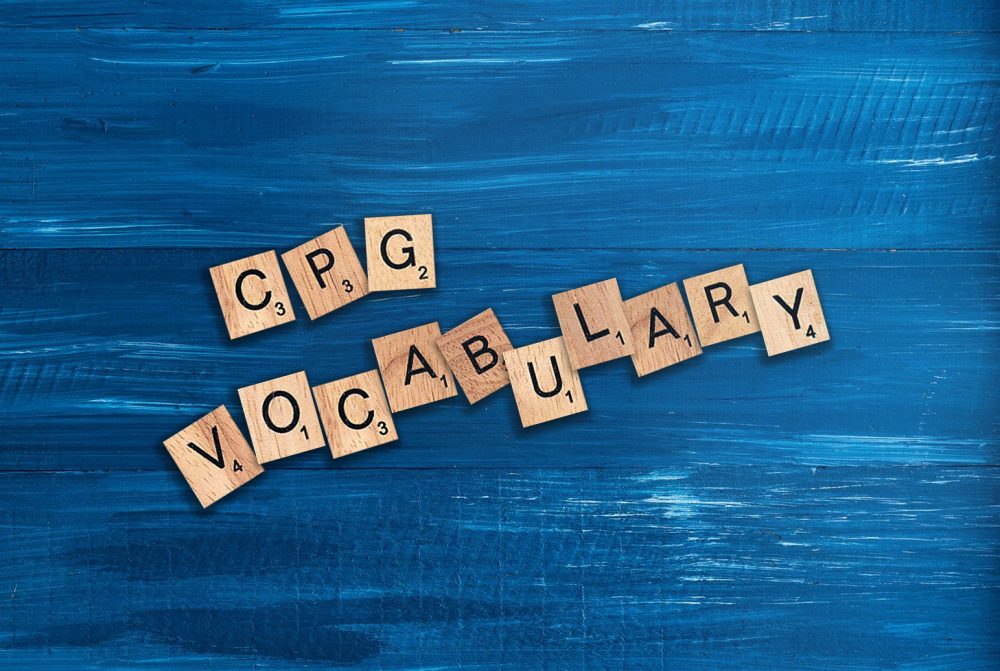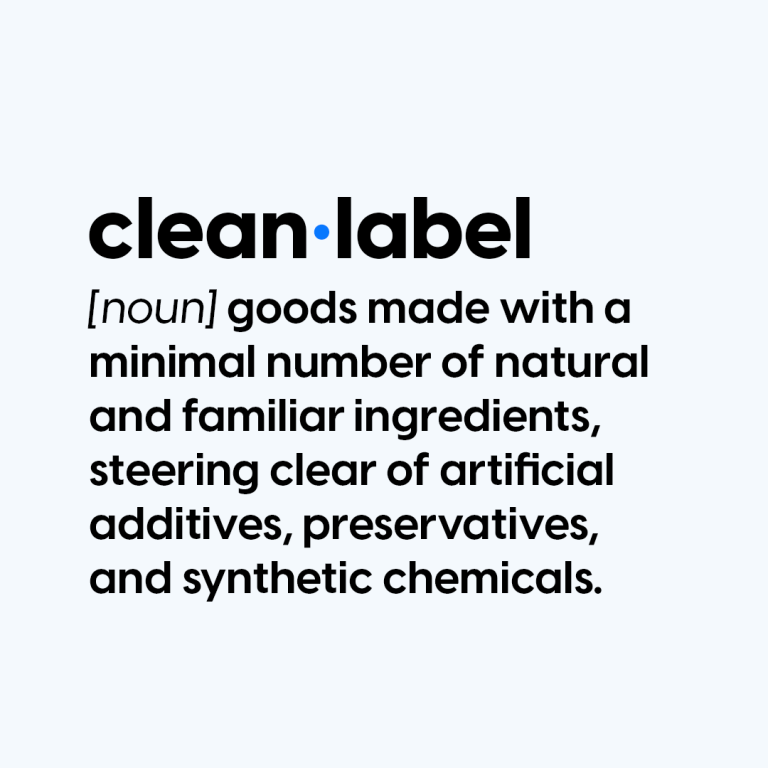The CPG industry is continually evolving their vocabulary as innovations with the channels and the industry as whole emerge. Learn more about the industry’s commonly used key phrases and what they mean.

A
All Commodity Volume (ACV): is a common way to measure the size of a store or retailer by determining the total retail dollar sales for an entire store across all products and categories. The
% ACV Distribution: (stands for All Commodity Volume Distribution Percentage) is the percentage that measures the breadth of distribution of a product.
% ACV with Merchandising: (stands for All Commodity Volume Merchandising Percentage) this is the method of measuring the breadth of merchandising support. Typically used to evaluate merchandising conditions like feature only or display only.
Absolute Change (Abs Chg): This is the method of measuring the change for a variety of variables from the current and previous year.
Absolute Discount: This is the method of measuring the dollar and cent difference of a product’s regular or base price versus the promoted or sale price.
Absolute-Minimum Pricing: the lowest price that a product or good can be sold at.
Advertising Allowance: is the dollar amount a manufacturer pays a retailer to advertise a product, brand or line.
Any Promotion: (can also be referred as “any merchandising”) stores that have any form of merchandising conditions (Price Reduction Only, Feature Only, Display Only, or Feature & Display).
AOC: (stands for All Outlet Combined) measures the total market for a product/product category that includes sales of that product from any channel – retail, direct, ecommerce, etc.
Attribute: (can also be referred as “Product Attributes” or “Characteristics”) describes the distinct features that sets the products apart from other. The attributes measure a variety of factors like size, color, package display and more.
Average Items Carried (AIC): being one of the two components to total distribution points, AIC measures the average number of items a retailer carries of a category, segment, brand, etc.
Average Items Selling (AIS): being one of the two components to total distribution points, AIS measures the average number of items a retailer sells of a category, segment, brand, etc.
Average Price: the average price a shopper pays for a product. This is measured by the total dollars spent by the total volume.
B
Base Price: the price calculated by base dollars divided by the base volume.
Base Sales: Amount that would have been sold if there was no merchandising.
Balanced Features: a merchandising condition that presents short-profit and long-profit products together as a combination sale.
Banner: a form of in-store advertising used to showcase in-store locations and products on sale.
BOGO: a form of price promotion which allows consumers to “buy one, get one”
Buying Committee: a review committee that evaluates and purchases new products, deals and special promotions.
Buying Habits: the assessment of your consumer audiences’ purchasing tendencies.
Buying Rate: (can be referred as “Item Sales per Item Buyer” or “Sales per Buyer”) Measured in dollars, units or volume- this is the average amount a product is purchased by a single household over an annual time period.
C
Case Code: (also known as Universal Product Code) the product’s distinctive machine-readable numeral code on its casing and pallet loads.
Category Analysis: an evaluation of a product category to define its strengths, weaknesses, etc.
Category Pricing: is the set pricing policy that determines that retail price for any and all products within a certain category.
Channel of Distribution: the path a product takes from grower, producer, manufacturer, broker, wholesaler, store to consumer.
Circular: a type of advertisement sent to a large amount of consumer, typically includes current sales and promotions.
Competitive Retailer Marketing Area (CRMA): The overall topography in which a retailer operates.
Consumer Promotion: a variety of marketing tactics to induce a specific consumer action.
Convenience Channel: (also known as C-Stores) one of the common retail channels within the CPG industry, typically in the forms of gas stations, standalone stores, and bodegas. This form of retails stores offers a limited stock product to its customers. Their products can range from staple pantry items, domestic beers, and quick snacks.
Coupon: is a discount offer that is redeemable at point of sale.
Cross-Merchandising: is the method is displaying related product by each other, for example pancake mix and syrup placed on the same shelves.
D
Deal Pack: the method of packaging products to showcase special customer promotions at a store.
Direct Buyer: a buyer that orders from the manufacturer without going through a wholesaler.
Display: is a temporary second location for a product aside from its regular shelf placement, typically found as an endcap or in-aisle display.
Display Execution: measures how much activity a display had when there was also a feature occurring at the same time. This is calculated by the week durations of the display divided by the week durations of any feature.
Distributors’ Brand: a retailer’s private label product brand.
Dollar Sales: the dollar amount a product was sold in retail. This is calculated by multiplying the unit sales and average price, divided by the unit.
Dollar Store: a retail channel that offer a limited number of products and typically sell their products for $1.
E
Early Bird Allowance: manufacturer’s incentive to retailers to order seasonal/promotional products in advance.
Equivalized (EQ) Sales: the volume of a product sold at retail.
Electronic Retailing: (also known as E-Tailing) is the sales of products and services through the Internet via online commerce website and applications.
F
FDMx: stands for “Food-Drug-Mass excluding Walmart,” meaning that a product is sold in those specific retail channels aside from Walmart.
Feature: (also known as a Flyer) is a printed advertising material distributed by the retailer usually weekly through newspapers, direct mail or in-store.
Field Representative: is a manufacturer’s agents that will go to retailers to deliver products and work on in-store displays.
Food Mass Merchandiser: A supercenter that offers a wide variety of food and non-food products.
Forward Buy: (also known as Buyout) is the method holding products until the end of a promotion to increase sale profits.
Frequent Shopper Program: a marketing method that allows customers to create a profile to receive discounts at a retailer, typically in a form of a scan card.
G
General Merchandise: Common non-food packaged goods sold with relatively low-prices and high selling rates.
Generic Brand (Product): is a product or good sold without a brand name.
Giveaway: a form of promotion that allows customers to receive free product when purchasing a certain amount of the product.
Grocery Wholesaler: the middleman who purchases a manufacturer’s goods to resell them in smaller quantities to retailers.
Group Advertising: retailers that combine their advertising efforts to reduce cost.
H
High-Low Pricing: a marketing technique that encompasses when a product maintains a high retail price but is frequently offered as a special with a discount.
Horizontal Display: the method of placing a line of similar products, forming a horizontal pattern across a single shelf.
I
Incremental Sales: is the measurement of total sales minus base sales.
Indirect Selling: when a manufacturer sells a product to wholesale merchandisers, that in turn will sell the products to retailer.
Institutional and Industrial Buyers: Institutions like schools and restaurants that purchase products from a wholesale grocer for consumption purposes.
Items Per Hour: the average that an item or good is scanned at the register within a hour.
K
Kitting: merging in-store marketing material to create a kit.
L
Lift: refers to the percentage of increase in sales, calculated by divide incremental sales from base sales and multiplying it by one hundred.
Line Extension: when brand expand their product line to offer a new flavor, formulation, scent, size or packaging shape to the portfolio
List Price: (also known as Base Price) the dollar amount at which an item is sold for
Logistics: the actions related to the procurement, warehousing and transportation of items for sale.
M
Market Share: the measurement of product performance in comparison to competitors, calculated by dividing brand sales from category sales.
Merchandising Condition: a variety of methods and techniques manufacturers pay retailers to promote their product to increase sales. The common four conditions retailers use are Feature without Display, Display without Feature, Feature & Display (F&D), and Temporary Price Reduction Only (TPR or TPR Only).
Merchandising Efficiency: the measurement of how effective the merchandising is excluding promotions.
MULO: (stands for Multi Outlet) means in the inclusion of the following retail channels – Food/Grocery, Drug, Mass Merchandisers, Walmart, Club Stores, Dollar Stores, Military DECA. “MULO C” offers the same channels with the inclusion of Convenience Stores.
Mystery Buyer: an anonymous representative that visits retails stores to evaluate store conditions, customer service or other things without influencing the actions of store personnel.
N
Natural Channel (also referred as Organic Channel): specialty retailers the mainly sell natural and organic products to consumers.
Nielsen Company: an auditing services that collects point-of-sale scanner data from retailers to provide a plethora of data and assessments.
Nitro software: is a Nielsen software for analysis and reporting on providing a foundation for understanding the key features and functions of retrieving data.
Non-Promoted Price: is the price paid by customers in stores where the product is not on sale.
Non-Promoted Sales: is the amount a product sold in stores with no merchandising present during that week.
O
On-Pack Promotion: a coupon or incentive that is attached to a product
Overlay: A secondary tactic included in a promotion to generate additional awareness or participation, or to customize the promotion for a specific retail account.
P
Pay Directs: coupons refunded directly to a retailer.
Penetration: is the percentage of households that have purchased a product/good or shopped a specific retail channel.
Perpetual Inventory System: is the system that maintains an expected inventory level within a store that reflects all physical product movement sales, deliveries, credits, etc.
Placement Allowance: the allowance manufacturers have when ordering new and promotional products.
Point of Sale (POS): During the checkout process when shopping – it is when products and goods are scanned through the register system allowing data to be collected and sales are tendered.
Price per EQ: the amount paid by consumers per equivalized unit (can be measured as pounds, ounces, etc.)
Price per Package: (also referred as Price Per Unit) is the amount paid by shoppers per package. This is typically used to analyze the prices of products with similar sizing.
Promoted Price: the dollar amount consumers paid for the product on sale.
Promoted Sales: the dollar amount sold in stores which included a form of merchandising at any point during the week
Purchase Allowance: a deal set by manufacturers to retailers that allows them to reduce the case price if an order is received during a promotional time period.
Purchase Frequency: the frequency that your product was purchased by the average household though a certain time period.
Purchase Size: the average amount of times a product was purchased by a single household on one shopping trip.
Q
Quality Discount: a reduction in price based on the quantity of cases purchased in a single order or over a specified time period.
Quality Merchandising: any form of merchandising conditions excluding TPR only.
R
Rebate: is the return of part of the original payment for a product or good. Typically, customers will have to submit an online or paper form in order to redeem the money back.
Remaining Market (ROM): this is the geographical region in which your competitors are in, but you are currently not in to showcase potential opportunity.
Reset: the revision of a planogram or display to introduce new products and improve the overall display merchandising.
Retail Channels: includes the various forms of retailers that a manufacturer can consider product placement at.
Rotation List: is the process of introducing limited edition or seasonal products that are only available in stores within a certain time period.
S
Sales Area: the section in a retail store designated to display and merchandise products, provide customer service and check out.
Sales per $MM ACV (“Sales per Million”): the measurement of how quickly a product is moving in its distribution stores.
Sampling: the marketing tactic of allowing shoppers to sample the product while in-store, encouraging them to purchase the product.
Specialty Channel: a type of retailer that offers only particular types of goods and products.
Stock Capacity: the total volume of products that can be placed on shelves.
Sweepstakes: a form of a promotional contest in which a consumer can have a chance to win prizes.
T
Temporary Price Reduction (TPR): reducing the price of a product or good for a temporary amount of time.
Tie-In Promotion: a promotional technique to pair two products together with a deal on one of the goods when a consumer purchases the other product.
Trade Promotion: when a retailer is paid by a manufacturer to launch in-store techniques to increase product sales.
Trading Area (TA): A geographical region with similar demographics, buying patterns and expectations.
U
UCS (Uniform Communications System) Ordering System: is an electronic system that transmits data, orders, promotional information and price changes between manufacturer and distributor.
Unit Sales: expressed in packages, this is the physical volume of product sold at retail.
Unplanned Purchase: when a consumer purchases a good or product that they didn’t intend on purchasing until they were in-store.
V
Velocity: the measurement the sales movement of a product measured against the category.
Vendor Shop: An area of the store specially dedicating to advertising a single brand or product vendor.
Volume Decomposition: The assessment of attributes that result in change in sales due to various business drivers.
W
Warehouse: the distribution outlet that works with retailers to order, store and ship merchandise.
Weekly Sales Log: the tracking of sales with a description of the factors affecting those sales in a week time frame.
Wholesaler: a company that buys directly from a manufacturer and sells to retailers.
X
xAOC: stands for “eXtended All Outlet Combined” and include all retail channel with the exception of Convenience stores.
Z
Zero Suppression: reducing the UPC code of a product by removing the zeros
Zoning: organizing a product set so that it conforms to the current planogram.







